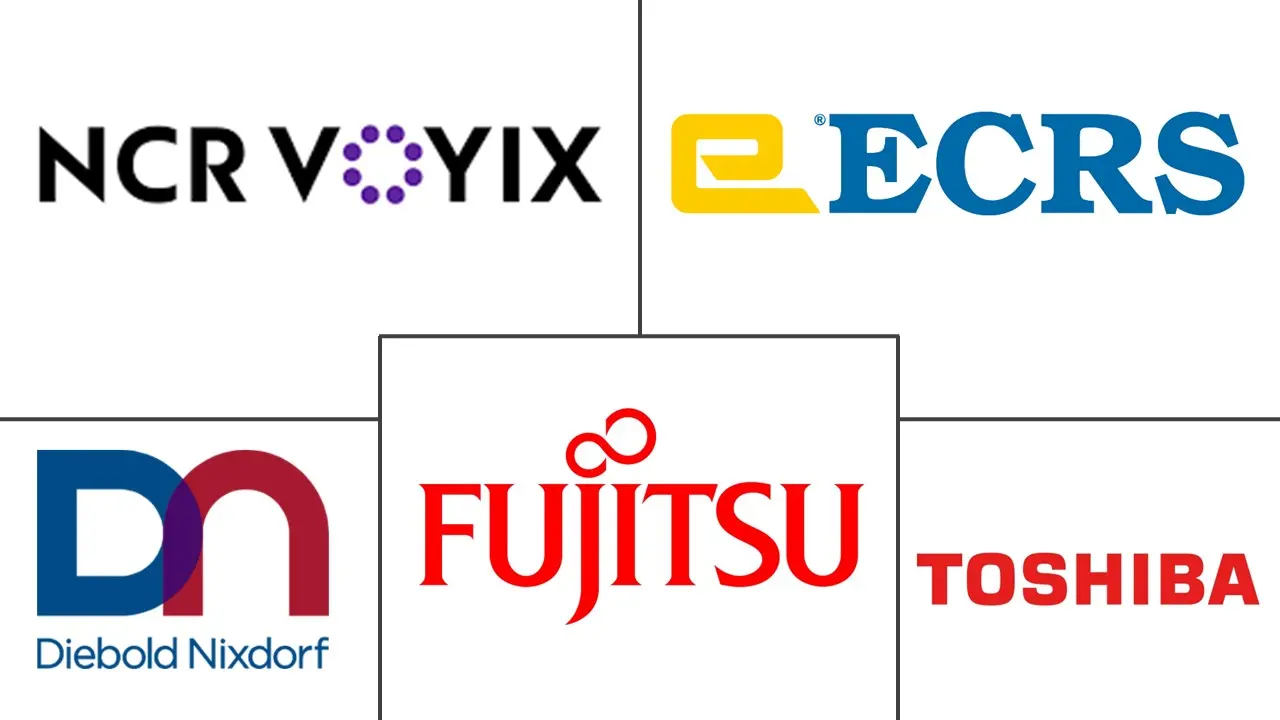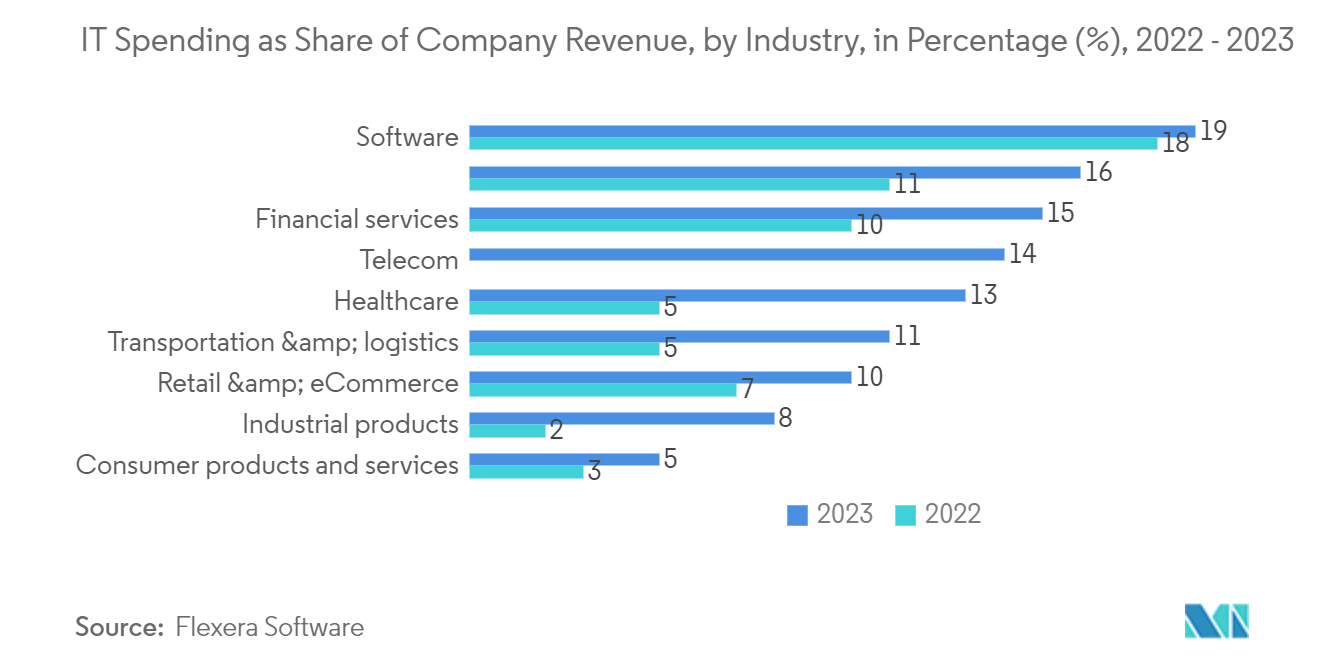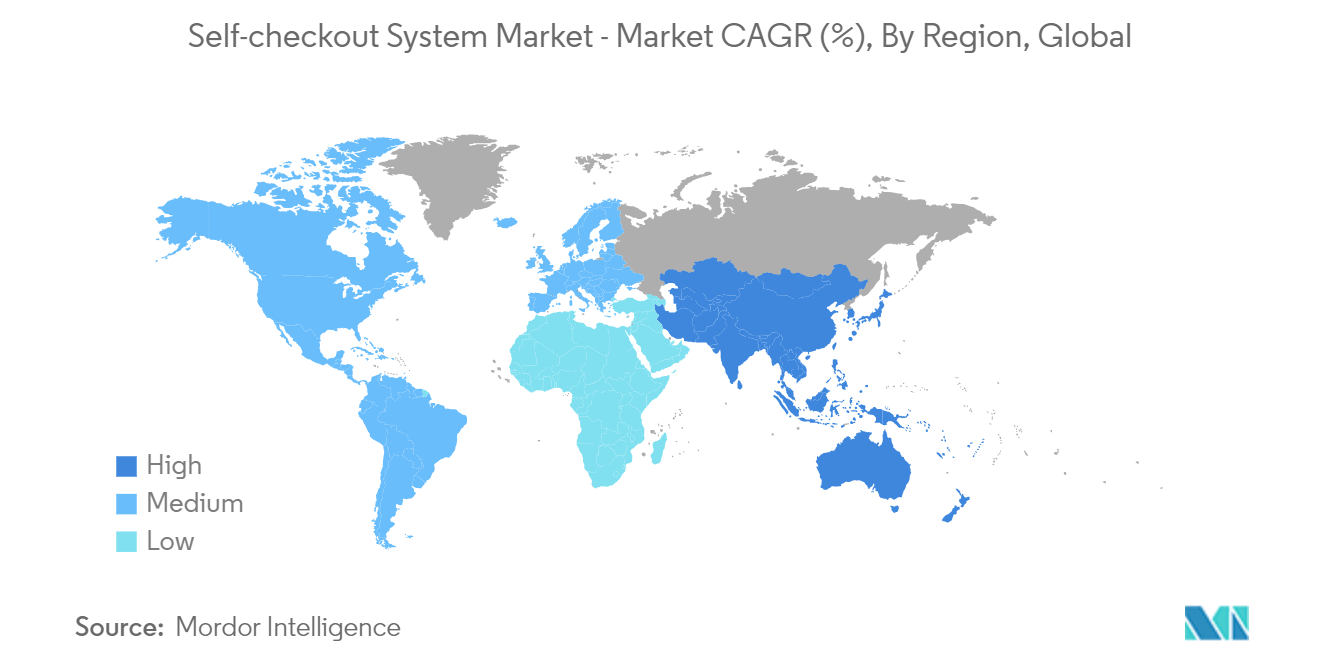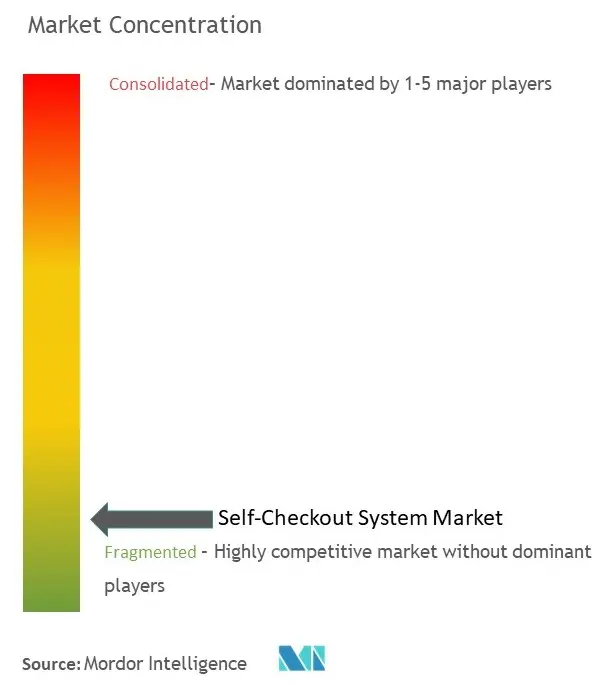Self-Checkout System Market Size

| Study Period | 2019 - 2029 |
| Market Size (2024) | USD 5.14 Billion |
| Market Size (2029) | USD 9.75 Billion |
| CAGR (2024 - 2029) | 13.68 % |
| Fastest Growing Market | Asia Pacific |
| Largest Market | North America |
Major Players
*Disclaimer: Major Players sorted in no particular order |
Self-Checkout System Market Analysis
The Self-checkout System Market size is estimated at USD 5.14 billion in 2024, and is expected to reach USD 9.75 billion by 2029, growing at a CAGR of 13.68% during the forecast period (2024-2029).
Self-checking systems are increasingly gaining momentum in the retail sector as self-checkout facilities usher in a new era of contactless shopping experiences within the store, aligning with evolving consumer preferences for minimal physical interaction.
- Consumers increasingly prefer to minimize physical contact during their shopping experience during the COVID-19 pandemic, and self-checkout stations provide a convenient and hygienic solution. These systems allow customers to independently scan items, pay using contactless payment options, and reduce interaction with store staff. As retailers strive to meet consumer preferences and enhance the overall shopping experience, the adoption of self-checkout systems is growing.
- Consumers are increasingly gravitating towards self-checkout options, allowing them to take greater control over their in-store transactions. This shift empowers consumers to personalize their shopping experiences according to their preferences. In response, brands are integrating more self-checkout features into their mobile apps, thereby enhancing the in-store journey. This strategy aligns with hyper-personalization efforts, enabling brands to offer customized promotions and pricing.
- The rapid expansion of the global retail sector is significantly driving the demand for self-checkout systems. As retailers aim to meet the evolving needs of consumers, they are increasingly adopting innovative technologies to enhance the shopping experience. Self-checkout systems offer several benefits, including reduced wait times, improved customer satisfaction, and increased operational efficiency. As the retail sector continues to grow and become more competitive, the demand for self-checkout solutions is expected to remain strong, particularly in regions with high population growth and busy retail environments.
- However, resistance from some consumers, particularly older individuals, to adopt new technology and awareness about the use of self-checkout systems challenges market growth. Additionally, many retailers face significant obstacles, including increased theft rates, long lines that deter shoppers during peak hours, and the high costs associated with expanding these systems to more lanes.
- The economic growth and shifting consumer spending patterns have driven the expansion of the retail sector. With the economic growth, the average income has increased, which has resulted in increased consumer spending on goods and purchases, including retail purchases.
Self-Checkout System Market Trends
Retail Industry to be the Largest End User
- Self-checkout systems are increasingly being deployed in bustling retail settings, such as grocery and convenience stores, where customers often buy multiple items, thereby fueling the market's expansion.
- AI-driven self-checkout systems are bolstering the growth of retail stores. In January 2024, market player Diebold Nixdorf unveiled a new technology for its cashierless registers, leveraging AI to mitigate shrinkage, verify age for liquor purchases, and expedite transactions for items without barcodes. Furthermore, Diebold Nixdorf's technology utilizes computer vision to swiftly identify produce types and quantities, enhancing the checkout speed.
- In November 2023, US-based Metz Culinary Management, Inc. announced its plans to roll out a contactless checkout system across retail locations. This system streamlines the checkout process, minimizing time spent in cashier lines. Shoppers can simply place items on a scanner for instant checkout. Metz, in collaboration with Marymount Manhattan College and Amazon, is set to debut its 'Just Walk Out' C-store concept in early 2024. This innovative system allows shoppers to enter using credit card or palm recognition, select items, and exit seamlessly. Purchases are automatically charged to their card upon leaving.
- In conclusion, consumers increasingly favor brick-and-mortar stores with self-checkout options to bypass long lines, which drives market adoption. Self-checkout systems also cater to privacy-conscious shoppers, allowing discreet purchases with minimal associate interaction. Such conveniences boost in-store foot traffic, signaling a promising growth trajectory for the retail market in the coming years.
- Customer shopping behaviors have undergone a significant transformation in recent years. The rise of retail automation and a growing emphasis on enhancing customer experiences are steering the retail sector toward embracing various technological advancements. Consumers seek seamless shopping and crave AI-driven product suggestions, fueling the surge in self-checkout systems implementations. These are pivotal in driving the momentum towards self-checkout options at retail outlets.
- According to Flexera Software, the retail & e-commerce industry witnessed increased information and technology (IT) spending in 2023. In 2023, the retail industry witnessed 10% of IT spending as a share of company revenue compared to 7% in 2022 globally.

North America Holds Largest Market Share
- Retail operators in the region grapple with challenges like escalating employee and real estate costs alongside fierce competition from e-commerce channels. Consequently, these operators are prioritizing productivity enhancements and overhead cost reductions.
- Retail store chains in the North American region are increasingly installing self-checkout systems, driven by changing consumer preferences for offline purchases and personal product testing. These self-checkout systems not only enhance the consumer experience but also allow retailers to cater to a broader customer base and gain a competitive edge. Furthermore, ongoing advancements and automation in the US retail sector are poised to bolster market growth in the coming years.
- Another pivotal factor fueling market growth is the rising consumer inclination toward self-service solutions. Particularly, tech-savvy shoppers in the US and Canada are seeking convenient, secure, and self-assisted experiences in retail environments. As technology evolves, retailers are swiftly adopting cashless self-checkout systems, enabling secure shopping and checkout without manual intervention.
- For instance, in April 2024, grocery retailer ALDI teamed up with Grabango to introduce ALDIgo, a checkout-free shopping experience, at a store in suburban Chicago. The Grabango system was seamlessly integrated into an existing ALDI store, requiring no alterations to the store’s planogram or product displays. Utilizing computer vision technology, the system identifies and monitors every item in the store, enabling shoppers to leave without waiting in line or manually scanning their purchases.
- Additionally, Self-checkout systems are advancing, driving market growth. Manufacturers are increasingly integrating cutting-edge technologies like Artificial Intelligence (AI), machine vision systems, and ceiling-mounted cameras into self-checkout systems, aiding retailers in reducing shoplifting incidents.
- Along with various global and regional players, solutions are equipped with the latest technologies. For instance, in July 2024, Partner Tech USA Inc., a global leader in intelligent POS and self-service solutions, unveiled its latest self-checkout software. This new version, equipped with cutting-edge AI capabilities, streamlines transactions, curbs fraud, and reduces the need for customer intervention, thereby enhancing the overall self-checkout experience. These technological advancements, combined with their widespread adoption in the region, are set to drive the growth of the Market Studied during the forecast period.

Self-Checkout System Industry Overview
The degree of competition in the Self-Checkout System Market is high and expected to remain the same over the forecast period. The market consists of long-standing established players who have made significant investments to improve product technology.
Some of the vendors include Diebold Nixdorf, Inc., Fujitsu Ltd, NCR Voyix Corporation, and Toshiba Global Commerce Solutions, among others. The new players entering the market require a high level of capital requirement, technology innovation, and advertising. However, this is quite simple for the key players in the industry. The companies can sustain themselves through powerful competitive strategies like technological collaborations, extensive investments in R&D, and acquisitions.
Self-Checkout System Market Leaders
-
Diebold Nixdorf, Inc.
-
Fujitsu Ltd.
-
NCR Corporation
-
ECR Software Corporation
-
Toshiba Global Commerce Solutions
*Disclaimer: Major Players sorted in no particular order

Self-Checkout System Market News
- August 2024 - Megasuper, Costa Rica's significant retailer, announced the installation of the Self Checkout System 7 by Toshiba Global Commerce Solutions in its stores. With this initiative, Megasuper positions itself as a significant player among retailers in the country, providing consumers with advanced shopping experiences via advanced self-checkout solutions.
- April 2024 - ECRS, a player in grocery store automation, launched its next-gen self-checkout system, QuickCheck, tailored for local and regional retailers. ECRS's QuickCheck prioritizes reliability, cost-effectiveness, and efficiency, setting it apart from the industry's typical cash recyclers. This advanced solution guarantees superior performance and swift transactions by integrating trusted, non-recycling cash management devices.
Self-Checkout System Market Report - Table of Contents
1. INTRODUCTION
- 1.1 Study Assumptions and Market Definition
- 1.2 Scope of the Study
2. RESEARCH METHODOLOGY
3. EXECUTIVE SUMMARY
4. MARKET INSIGHTS
- 4.1 Market Overview
-
4.2 Industry Attractiveness - Porter's Five Forces Analysis
- 4.2.1 Bargaining Power of Suppliers
- 4.2.2 Bargaining Power of Buyers/Consumers
- 4.2.3 Threat of New Entrants
- 4.2.4 Threat of Substitute Products
- 4.2.5 Intensity of Competitive Rivalry
- 4.3 Industry Value Chain Analysis
- 4.4 Assessment of the Impact of Macroeconomic Trends on the Market
5. MARKET DYNAMICS
-
5.1 Market Drivers
- 5.1.1 Increased Speed of Checkout
- 5.1.2 Addressal of the Labor Shortage Issues Across the Emerging Countries
-
5.2 Market Challenges/Restraints
- 5.2.1 Reluctance/Lack of Awareness to Use Self-Checkout Systems
6. MARKET SEGMENTATION
-
6.1 By Offering
- 6.1.1 Hardware
- 6.1.2 Software
- 6.1.3 Services
-
6.2 By Transaction Type
- 6.2.1 Cash
- 6.2.2 Cashless
-
6.3 By Model Type
- 6.3.1 Standalone
- 6.3.2 Countertop
- 6.3.3 Mobile
-
6.4 By End-user Industry
- 6.4.1 Retail
- 6.4.2 Entertainment
- 6.4.3 Travel
- 6.4.4 Financial Services
- 6.4.5 Healthcare
- 6.4.6 Other End-user Industries
-
6.5 By Geography***
- 6.5.1 North America
- 6.5.2 Europe
- 6.5.3 Asia
- 6.5.4 Australia and New Zealand
- 6.5.5 Latin America
- 6.5.6 Middle East and Africa
7. COMPETITIVE LANDSCAPE
-
7.1 Company Profiles*
- 7.1.1 Diebold Nixdorf, Inc.
- 7.1.2 Fujitsu Ltd.
- 7.1.3 NCR Corporation
- 7.1.4 ECR Software Corporation
- 7.1.5 Toshiba Global Commerce Solutions
- 7.1.6 ITAB Scanflow AB
- 7.1.7 Pan-Oston Corporation
- 7.1.8 DXC Technology
- 7.1.9 Slabb Kiosks
- 7.1.10 ShelfX Inc.
- 7.1.11 Pegasus (Pegasus Turnkey Solution (OPC) Private Limited)
- 7.1.12 Ombori
8. INVESTMENT ANALYSIS
9. MARKET OPPORTUNITIES AND FUTURE TRENDS
** Subject To AvailablitySelf-Checkout System Industry Segmentation
Self-checkout systems, now prevalent in retail, grocery, and hospitality sectors, empower customers to complete transactions and place orders independently. In response to evolving demands, today's self-checkout systems undergo tailored re-engineering and manufacturing, enhancing store compatibility, functionality, cost-effectiveness, form factor, and reliability. As secure, self-payment technologies gain traction, kiosk vendors are increasingly offering cashless solutions, a trend poised to drive market growth in the coming years.
The self-checkout system market is segmented by offering (hardware, software, services), by transaction type (cash, cashless), by model type (standalone, countertop, mobile), by end-user industry (retail, entertainment, travel, financial services, healthcare, other end-user industries), by geography (North America, Europe, Asia-Pacific, Latin America, Middle East and Africa). The report offers market forecasts and size in value (USD) for all the above segments.
| By Offering | Hardware |
| Software | |
| Services | |
| By Transaction Type | Cash |
| Cashless | |
| By Model Type | Standalone |
| Countertop | |
| Mobile | |
| By End-user Industry | Retail |
| Entertainment | |
| Travel | |
| Financial Services | |
| Healthcare | |
| Other End-user Industries | |
| By Geography*** | North America |
| Europe | |
| Asia | |
| Australia and New Zealand | |
| Latin America | |
| Middle East and Africa |
Self-Checkout System Market Research FAQs
How big is the Self-checkout System Market?
The Self-checkout System Market size is expected to reach USD 5.14 billion in 2024 and grow at a CAGR of 13.68% to reach USD 9.75 billion by 2029.
What is the current Self-checkout System Market size?
In 2024, the Self-checkout System Market size is expected to reach USD 5.14 billion.
Who are the key players in Self-checkout System Market?
Diebold Nixdorf, Inc., Fujitsu Ltd., NCR Corporation, ECR Software Corporation and Toshiba Global Commerce Solutions are the major companies operating in the Self-checkout System Market.
Which is the fastest growing region in Self-checkout System Market?
Asia Pacific is estimated to grow at the highest CAGR over the forecast period (2024-2029).
Which region has the biggest share in Self-checkout System Market?
In 2024, the North America accounts for the largest market share in Self-checkout System Market.
What years does this Self-checkout System Market cover, and what was the market size in 2023?
In 2023, the Self-checkout System Market size was estimated at USD 4.44 billion. The report covers the Self-checkout System Market historical market size for years: 2019, 2020, 2021, 2022 and 2023. The report also forecasts the Self-checkout System Market size for years: 2024, 2025, 2026, 2027, 2028 and 2029.
Self-Checkout System Industry Report
The Self-Checkout System market report provides a comprehensive industry overview and market analysis, focusing on various segments such as hardware, software, and services. The report highlights the market share and market size, offering insights into market trends and market growth within the self-checkout system industry.
The market segmentation includes transaction types like cash and cashless, and model types such as standalone, countertop, and mobile. Furthermore, the report delves into different end-user industries, including retail, entertainment, travel, financial services, and healthcare, along with a detailed market forecast and market predictions for these sectors.
Geographically, the market analysis covers regions like North America, Europe, Asia Pacific, Latin America, and the Middle East & Africa. The industry reports and industry research provide valuable industry statistics, industry information, and industry trends, which are crucial for understanding the market outlook and industry outlook.
Additionally, the report includes a market review and discusses the market leaders, offering a thorough industry analysis and insights into the market value and market data. The report also provides a sample report PDF for further reference, serving as a report example for those interested in detailed market research.
Overall, the report offers a robust analysis of the self-checkout system market, including industry sales, industry size, and the growth rate of the market. This comprehensive market report is essential for research companies and stakeholders looking to understand the dynamics and future prospects of the self-checkout system industry.



